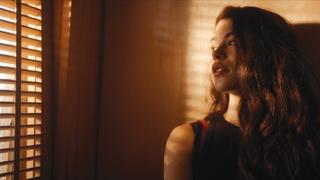Daylight Lighting With HMIs
They give the punch to balance exposure between interior and exterior

On location during the day, whether shooting ENG or scripted, we often walk into a space and survey the existing light that is available. With regards to daylight specifically, this includes the general ambient light in the space, windows and the location of the sun. There are plenty of situations where crews just use the available light, however, in most cases you are looking to enhance it and actually light the scene.
SUPPLEMENTING DAYLIGHT
Probably the biggest goal of daylight units is to give direction to the ambient daylight. HMI lighting has been the go-to for supplementing daylight due to its efficiency at converting electricity to light. Their output is four times greater than that of a tungsten unit. They can push in from the outside to add highlights inside an interior location, either on the walls or as backlights on subjects. They do not need to be hard—they can provide a powerful but soft push as well by adding a variety of diffusion flavors.
On a short form piece I recently worked on called “Mary, Meet Grace,” HMIs were used as soft pushes to extend the exterior daylight inward and to key actors. An effective method to use is light from the outside but HMIs can also be used on the inside of a set as well.
On the interior of a location, HMIs can help match with the intensity of the exterior daylight when the camera is pointed toward a window or open doorway. You not only have the necessary punch of an HMI to balance exposure between interior and exterior, but also the ability to soften the HMI to the point of creating a very realistic effect of return.
In other words, HMI lights are so powerful that you can soften them enough to have them act as a key light that mimics a bounce of the actual sunlight coming in. They will not look “sourcey,” in other words, too lit and obvious, when shaped and softened from the inside. There is enough output to knock down their intensity a bit without losing too much exposure on camera. The only downside of this is that these units are large due to their specific bulbs and housing, so having space is key if you want to stick something like an ARRI M40 inside as a key light.
LEVERAGING OUTPUT
Though LEDs are great at imitating daylight color-wise and currently super popular, they still don’t give the punch that HMIs do, simply because they’re an array. The way HMI fixtures are built is what really leverages output, with both fresnel and par options. The lens on an HMI fresnel creates a beam that can be narrowed or widened depending on a variety of lenses and a par HMI takes the light hitting the back of the housing and sends it forward for the maximum push. Each is basically a giant point source as opposed to a panel of smaller sources.
LED lights can still be pushed through windows for a softer, wider beam. They are great for simulating streetlight at night and can still be used as daylight but will not give a specific shape like a streak of daylight on a wall. It is also much harder for them to compete with the natural daylight and they won’t read very well on camera depending on the strength of the unit.

While HMIs are the choice for pushing daylight through a set, other units like LED or tungsten lights can be of use for certain effects. Tungsten units, if powerful enough, can also push through to give a feeling of warm daylight when the sun is lower in the sky. They are still hard like HMI sources if they’re a fresnel or par can, just not as powerful, so a much greater unit in wattage amount is needed.
I recently worked on a music video where tungsten came in handy. We placed a par can outside a smaller window to push a distinct warm shape for a particular performance take. If simulating something like sunset, tungsten doesn’t have to be made to match anything necessarily and it seems to do a beautiful job without needing to be corrected with gel.
Bottom line, if you are shooting in daylight, having daylight units, particularly HMIs, will most efficiently allow the supplementing and shaping of light. Other units can serve other purposes in a daylight scenario, but these are best for matching daylight’s color and extending its quality into an interior location.
Julia Swain is a cinematographer whose work includes films such as “Lucky” and “Speed of Life” alongside dozens of commercials and music videos. She continues to shoot on a variety of formats, seeking to create compelling visuals for every story and brand. She can be reached through TV Tech.
Get the TV Tech Newsletter
The professional video industry's #1 source for news, trends and product and tech information. Sign up below.
